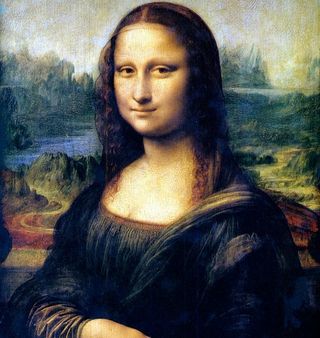Mona Lisa: A Few Feet Under Concrete?

The mysterious face of the Mona Lisa may be lying under a few feet of cement in a decrepit convent in Florence, Italy. Researchers are currently searching for the bones of what might turn out to be Lisa Gherardini Del Giocondo, the woman many art historians believe to be the inspiration of the iconic painting.
And while they haven't hit pay dirt, last week they took a leap in the right direction: The team members announced they had discovered what may be steps leading down to a crypt where the model is thought to be buried, according to historical documents.
The convent above the stairs, called St. Ursula in Florence, was where Gherardini died in 1542. It was built in 1309 and was used by the church until 1810 when it was converted into a tobacco factory, then used as a shelter during World War II, before it housed university classrooms. Since a failed attempt to turn it into a barracks in the 1980s, the compound has remained empty.
Researchers, including historian Giuseppe Pallanti who published the book "Mona Lisa Revealed: The True Identity of Leonardo's Model" (Skira, 2006), believe that Gherardini's husband, Francesco del Giocondo, commissioned their neighbor Leonardo Da Vinci to paint a portrait of his wife in 1502, around the time she was pregnant with their second child. Da Vinci took until 1519 to hand over the painting, carrying it around with him on his travels and not giving it up until his death, according to the theory. The painting currently hangs in the Louvre museum in Paris.
Historical records, including Gherardini's death certificate discovered a few years ago, place her death at St. Ursula's, where she spent her last two years after her husband's death. The documents note that there is a crypt beneath the church floor, where Gherardini would have been buried.
Excavating and exhumation
The work of excavating the dilapidated building started in late April, led by Silvano Vinceti, the chairman of the nongovernmental organization National Committee for the Promotion of Historical Heritage, Culture and Environment. The group has also uncovered the supposed remains of Italian artist Michelangelo Merisi da Caravaggioand reconstructed the face of Dante Alighieri, an Italian poet known for writing the "Divine Comedy" about a fictional journey through hell.
Sign up for the Live Science daily newsletter now
Get the world’s most fascinating discoveries delivered straight to your inbox.
The team first scanned the floor of the nunnery using ground-penetrating radar, which could "see through" the cement floor poured during renovations in the 1980s. They used this data to identify the area where the crypts could be located in and around the church and convent.
The team started excavating the site on May 9; they've uncovered a few inches of the floor and have discovered a layer of ancient bricks, each about 35 inches (90 centimeters) wide, possibly steps leading to the tombs or a series of crypts.
"The finding is consistent with our records," Vinceti said in a statement to Italian news agency ANSA. "We should be where the altar once stood, and where a trapdoor led to the crypt we saw on the georadar scan."
Finding her bones
They need to continue excavating the area for possible bones. If they find enough skull bones, Francesco Mallegni, a paleoanthropologist at the University of Pisa, will attempt to reconstruct Gherardini's face, providing extra clues to who was really the subject of the painting, according to ANSA English.
"The excavation is still just the beginning, we made a few inches," Vinceti said to ANSA. "We should go for at least two feet and will serve at least a week of work to get a better picture of the situation."
They will also test the genetic material of the bones and compare it to DNA from Gherardini's children, who are buried in Florence's Santissima Annunziata church. This would prove that the bones found at the convent were actually hers.
You can follow LiveScience staff writer Jennifer Welsh on Twitter @microbelover. Follow LiveScience for the latest in science news and discoveries on Twitter @livescience and on Facebook.
Jennifer Welsh is a Connecticut-based science writer and editor and a regular contributor to Live Science. She also has several years of bench work in cancer research and anti-viral drug discovery under her belt. She has previously written for Science News, VerywellHealth, The Scientist, Discover Magazine, WIRED Science, and Business Insider.

